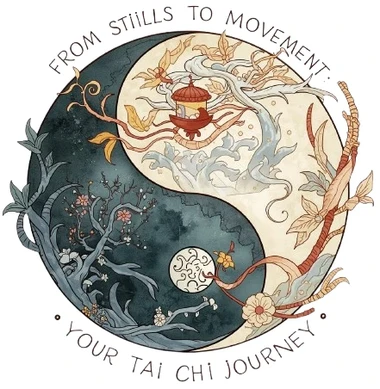Let's be real.
Finding a workout that is gentle, effective, and free is tough. Maybe you feel too busy for the gym.
Or high-intensity workouts leave you drained.
What if you could feel stronger and more relaxed in just 15 minutes a day? Honestly, that's the deal with Ba Duan Jin.
This ancient practice is like a superpower for your health.
And it requires no equipment or special skills. At Tai Chi Wuji, we love sharing these powerful, traditional exercises.
They are designed for modern, busy lives like yours.
Let's explore this amazing practice together.
What Exactly Is Ba Duan Jin?
Ba Duan Jin means "Eight Sections of Brocade." It is a famous set of Chinese Qigong exercises. Think of it as a moving meditation.
Its history goes back over 800 years. The name is a beautiful metaphor. Brocade was a precious, finely woven silk in ancient China.
These eight movements are just as valuable and interconnected. They weave together your physical and mental health.
Each section targets different areas of your body.
Together, they create a complete workout for your whole system. It is a cornerstone of traditional Chinese health practices.
A Quick Peek at Its Long History
Ba Duan Jin's roots are in ancient China. The first written records appear in the Song Dynasty.
A book called Yijian Zhi from the 12th century mentions it. Back then, it was a secret practiced by scholars and monks.
It was passed down through generations. Different masters developed their own styles. You will find seated and standing versions.
There are also northern and southern styles.
In the 1950s, the Chinese government saw its value. They worked with experts to create a standard version. This is the one most people learn today.
Its longevity proves its incredible benefits.
The 8 Moves at a Glance
Here is a simple table to show you the core of each movement.
It is your quick-reference guide to the entire practice.
| Movement Number & Name | Main Focus | Key Benefit |
|---|---|---|
| 1. Two Hands Hold Up the Heavens | Stretching the torso | Regulates all internal systems (San Jiao) |
| 2. Drawing the Bow to Shoot the Hawk | Opening the chest & shoulders | Strengthens lungs & heart |
| 3. Separating Heaven and Earth | Alternating push & pull motions | Improves digestion & spleen health |
| 4. Looking Backwards | Gentle spinal twist | Relieves stress & body stiffness |
| 5. Swaying Head and Tail | Wavelike spine movement | Calms the mind & reduces anxiety |
| 6. Two Hands Hold the Feet | Forward bend & back arch | Strengthens kidneys & lower back |
| 7. Clenching Fists and Glaring | Punching with focus | Builds inner strength & confidence |
| 8. Seven Bounces on the Toes | Gentle heel lifts | Balances energy & ends the practice |
This table makes it easy to see the logic. Each movement has a special job.
Together, they form a perfect health routine.
Why Your Body Will Thank You
The benefits of Ba Duan Jin are amazing. It works on your body and your mind.
Let's break down the key health perks.
- It Boosts Your Cardiovascular Health: The slow, deep breathing is key. It helps to slow your heart rate. This reduces strain on your heart. Better circulation is a major plus. Your entire body gets more oxygen.
- It Supercharges Your Respiratory System: Ba Duan Jin teaches you to breathe deeply. You learn to use your full lung capacity. This is great for your respiratory health. It can even help people with mild asthma. You will feel more energized.
- It Melts Away Stress: This is a huge benefit for modern life. The focused movements calm your nervous system. You cannot be stressed and relaxed at the same time. Ba Duan Jin teaches your body to relax. You will feel a sense of peace and calm. Many people report better sleep, too.
At Tai Chi Wuji, we see these changes every day. It is not just exercise. It is a tool for a happier, healthier life.
Stay tuned for our next part. We will break down the first four movements in detail!
You will learn exactly how to do them.
Let's Master the Movements: Your Step-by-Step Guide
Now for the fun part—learning the moves! Don't worry about being perfect. The goal is to move with awareness and breathe deeply.
At Tai Chi Wuji, we always tell beginners that consistency beats perfection every time.
Let's break down the first four movements.
Movement 1: Two Hands Hold Up the Heavens
This is the foundational move, like hitting the power button for your entire system. It involves a gentle, full-body stretch that awakens your circulation and coordination.
Start with your feet shoulder-width apart, knees softly bent. Imagine you are holding a beautiful, large ball of energy in front of your lower abdomen. Inhale slowly as you bring your hands up, crossing them in front of your chest.
Then, press your palms upward toward the sky as you straighten your legs. Feel that lovely stretch from your heels all the way to your fingertips.
Gently tilt your head back and look at your hands.
Hold for a moment, feeling the expansion. As you exhale, slowly separate your hands and lower them back down to your sides, bending the knees again.
This movement is wonderfully calming and helps to center your mind.
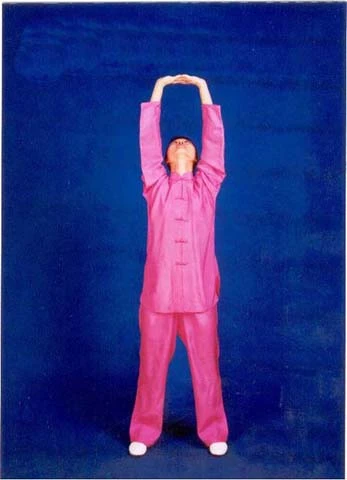
Movement 2: Drawing the Bow to Shoot the Hawk
This powerful stance makes you feel strong and focused. It is fantastic for opening up a tight chest and shoulders, which is perfect if you spend a lot of time at a desk.
Step out to the side into a low, comfortable horse-riding stance. Bring your hands up to chest level as if you are holding a giant bow.
Your left hand forms a "seven" (index finger up, thumb out) and pushes to the left, while your right hand makes a fist and pulls back to your shoulder, as if drawing the bowstring.
Turn your head to gaze past your left index finger. Hold the stance, feeling the stretch across your chest and back.
Inhale as you draw the bow, and exhale as you release the pose and return to the center.
Then, repeat on the other side. You will feel an incredible opening in your upper body.
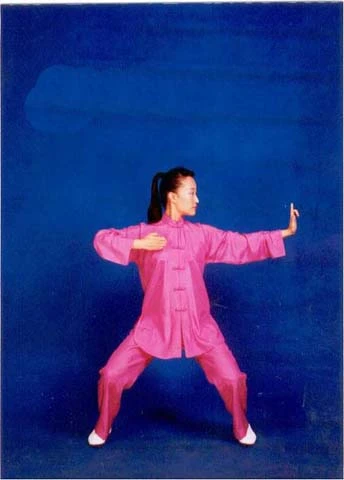
Movement 3: Separating Heaven and Earth
This move is all about creating balance and rhythm. The alternating up-and-down motion gives your digestive organs a gentle, internal massage.
Begin from a relaxed standing position. As you inhale, slowly lift your right palm upward overhead, fingers pointing left. Press up gently as if pushing the sky away. At the same time, press your left palm down toward the earth, fingers pointing forward. Feel a nice stretch along your entire side.
Exhale as you relax and bring both hands back down. Then, inhale and repeat the motion with your left hand rising and your right hand pressing down.
This alternating motion helps to regulate the spleen and stomach, which in Traditional Chinese Medicine are central to good digestion and energy levels.
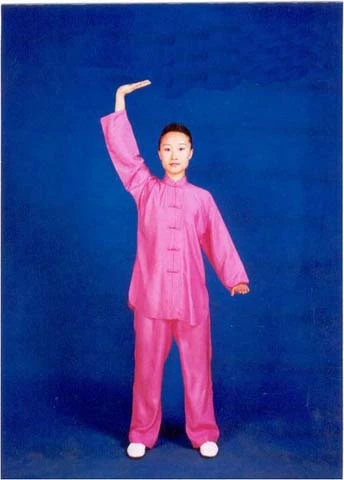
Movement 4: Looking Backwards
This is a simple but incredibly effective twist for releasing tension. We hold so much stress in our necks and upper backs, and this move helps to melt it away.
Stand with your feet shoulder-width apart. Keep your hips and legs facing forward. As you inhale, slowly and gently turn your head and upper body to look behind you over your right shoulder. Let your gaze drop toward your right heel. You can let your arms swing naturally, with your right hand resting on your left hip and your left hand on your right hip. Exhale as you smoothly return to the center.
Then, inhale and repeat the twist to the left side. The key is to move slowly and without force. This twisting action is said to help with "Five Fatigue and Seven Injuries," which is an ancient way of saying it relieves the accumulated stresses of daily life.
You have made it through the first half!
Now, let's explore the movements that truly connect the body and mind. These final four sections of Ba Duan Jin delve deeper into internal strength and calming the spirit.
At Tai Chi Wuji, we find that this is where many practitioners start to feel the profound mental benefits alongside the physical ones.
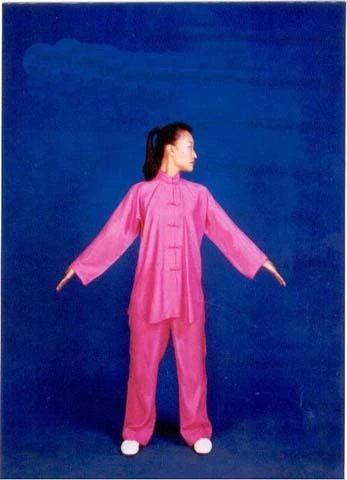
Movement 5: Swaying Head and Tail
This is often considered the most complex move, but don't let that intimidate you. Think of it as creating a gentle wave through your spine, which helps to soothe your nervous system and calm what Traditional Chinese Medicine calls "heart fire"—that feeling of stress, anxiety, or restlessness.
Start in a low, wide horse stance with your hands on your thighs. Inhale as you shift your weight to the right, leaning forward slightly and letting your head follow a gentle arc to look toward your right foot. Your body forms a soft curve.
Then, exhale as you sway through the center and over to the left side, again following the movement with your head and gaze.
The motion should be fluid and rocking, not jerky. The key is to keep your back and hips relaxed, allowing your spine to move freely.
This massages your internal organs and releases tension held in your core, leaving you feeling centered and calm.
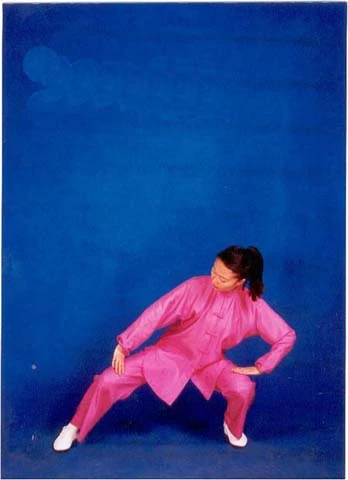
Movement 6: Two Hands Hold the Feet
This movement is a fantastic stretch for the entire back body, from your heels to your hamstrings and all the way up your spine. Its primary focus is on strengthening the kidneys and lower back, which are seen as the source of your vital energy.
Begin by standing straight. Inhale as you raise your arms overhead. Then, exhale as you bend forward from the hips, keeping your back straight as long as you can. Gently lower your hands toward your feet or the floor—go only as far as is comfortable without forcing it.
If you can, grasp your toes or ankles. Inhale and slightly lift your head to lengthen your spine. As you exhale, fold a little deeper.
To come up, engage your core and slowly roll your spine up, vertebra by vertebra, with your head coming up last. This deliberate movement builds incredible strength and flexibility in the lower back.
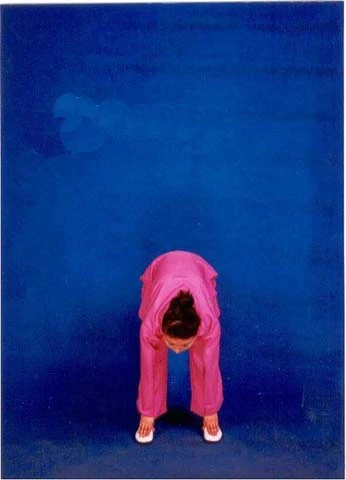
Movement 7: Clenching Fists and Glaring
This is the most outwardly powerful of the eight movements. It builds physical strength and channels your energy with fierce focus.
The "anger" in the eyes is not real anger, but a focused intention that helps to build your inner "Qi" or life force.
From a solid horse stance, place your fists on your hips, palms facing up. Inhale as you slowly punch your right fist forward, rotating it so the palm faces down at the end of the movement. The key is to punch with control, not speed, as if pushing through thick water.
At the same time, open your eyes wide and direct your intense gaze forward.
This "glaring" helps to activate the Liver meridian, which is linked to anger and energy in TCM, giving you a healthy way to release it. Exhale as you relax your hand and draw it back to your hip, then repeat on the left side.
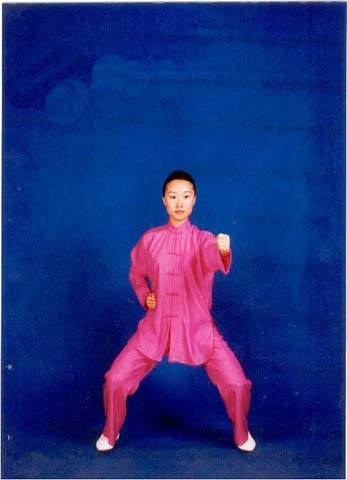
Movement 8: Seven Bounces on the Toes
This is the perfect, gentle finale to the practice.
It is surprisingly simple but very effective for smoothing out your energy flow and bringing your body back into balance after the previous movements.
Stand with your feet together and your hands resting gently at your sides. Inhale deeply as you slowly lift your heels off the ground, rising onto the balls of your feet. Pull your shoulders back slightly and feel a light stretch through your entire body.
Hold your breath for just a moment at the top. Then, exhale completely as you relax and let your heels drop back to the ground with a soft, gentle bounce.
This impact subtly vibrates the entire body, jiggling joints and muscles loose and encouraging circulation.
Repeating this seven times is believed to complete a cycle of renewal, leaving you feeling vibrantly alive and refreshed.
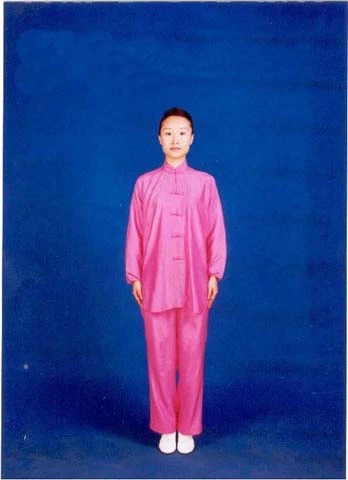
Your Journey with Ba Duan Jin: Key Principles for Success
Starting a new practice can feel overwhelming, but the beauty of Ba Duan Jin is its simplicity. You do not need to master every detail on day one.
The most important step is to begin and be consistent.
At Tai Chi Wuji, we guide our students to focus on a few core principles that make the practice safe, effective, and deeply rewarding.
Remember, this is a journey of self-discovery, not a performance.
First, always prioritize correct posture over deep stretching. It is better to do a small, aligned movement than a large, strained one.
Listen to your body; it will tell you when to ease up. Second, coordinate your breath with your movements.
Generally, you inhale during opening or rising motions and exhale during closing or sinking motions.
If you forget, just keep breathing naturally—never hold your breath. Finally, bring your mental focus to the practice.
This is what transforms it from mere exercise into a moving meditation. Pay attention to the sensations in your body and the flow of your breath.
Who is Ba Duan Jin For? (Spoiler: Everyone!)
One of the most common questions we get at Tai Chi Wuji is, "Am I the right person for this?" The answer is a resounding yes. Ba Duan Jin is remarkably adaptable. It is perfect for office workers seeking relief from desk-bound stiffness. It is ideal for seniors looking to maintain balance and joint health.
Athletes use it for active recovery and focus. Even busy parents can find a few minutes to practice and reset their nervous systems.
Because the movements are low-impact and can be modified, almost anyone can benefit.
If you have specific health concerns, it is always wise to consult with your doctor first. But for most people, this practice offers a safe and gentle path to better health.
You can start with just one movement a day and slowly build up to the full set. The goal is progress, not perfection.
How Ba Duan Jin Compares to Tai Chi and Yoga
You might be wondering how Ba Duan Jin fits in with other mindful exercises like Tai Chi and Yoga. Honestly, they are all fantastic, and each has its unique strengths.
Think of Ba Duan Jin as a perfect introduction to this world of mindful movement.
It is more accessible than a long Tai Chi form because it only has eight movements to remember. This makes it less daunting for absolute beginners.
Compared to Yoga, Ba Duan Jin is generally less focused on deep static stretching and complex poses. It emphasizes smooth, continuous flow and internal energy awareness. Many people find it easier to learn without worrying about flexibility.
In fact, practicing Ba Duan Jin can wonderfully complement your Yoga or Tai Chi practice, enhancing your body awareness and breath control. It is a complete system all on its own, but it also plays well with others.
Start Your Practice Today with Tai Chi Wuji
You now have everything you need to begin your own journey with Ba Duan Jin. You have learned the history, the benefits, and the step-by-step instructions for all eight movements. The only thing left to do is to take that first step.
Find a quiet space, stand up, and try the first movement. You do not need special clothes or a lot of time. Just show up for yourself.
We at Tai Chi Wuji are passionate about making these ancient practices accessible for modern lives.
We believe that everyone deserves to feel balanced, strong, and calm from the inside out. Ba Duan Jin is a powerful tool to help you achieve that.
So, take a deep breath, trust the process, and enjoy weaving this beautiful brocade of movement into your daily life.
Your body and mind will thank you for it.
Begin your journey into mindful movement today with the timeless practice of Ba Duan Jin.
Frequently Asked Questions (FAQ)
How long does it take to learn Ba Duan Jin?
You can learn the basic movements in a single session! The true mastery, however, comes with consistent practice. At Tai Chi Wuji, we recommend starting with just 10-15 minutes a day. Focus on the flow and your breathing rather than perfect form. Many people feel the calming effects and improved energy flow after just a few weeks of regular Qigong practice.
What is the main difference between Ba Duan Jin and Tai Chi?
Both are wonderful mind-body practices, but they have different focuses. Ba Duan Jin is a set of eight distinct exercises, making it simpler and faster to learn. It's ideal for building a foundation. Tai Chi is a longer, continuous martial arts form that emphasizes complex sequences and self-defense applications. Think of Ba Duan Jin as a perfect introduction to the world of internal energy work that Tai Chi also explores.
Can Ba Duan Jin help with back pain?
Absolutely. Many of the movements are excellent for spinal health. The gentle stretching and twisting in moves like "Looking Backwards" and "Two Hands Hold the Feet" help to increase flexibility and strengthen the core and back muscles. By improving posture and releasing tension along the spine and meridians, Ba Duan Jin can provide significant relief from chronic discomfort.
Is the breathing in Ba Duan Jin complicated?
Not at all! The basic rule is simple: inhale during opening and rising motions, and exhale during closing and sinking motions. If you forget, just focus on keeping your breath deep, slow, and natural. Never force or hold your breath. The coordination of breath and movement is a core part of its meditative benefits and effectiveness.
I'm not flexible. Can I still do Ba Duan Jin?
Yes, and this is a very common concern! Ba Duan Jin is designed to improve your flexibility gently over time. You should never force a stretch. Move only within your comfortable range of motion. The goal is to feel a gentle pull, not pain. With regular practice, you will be amazed at how your range of motion and joint health improve naturally.
What should I wear to practice?
Comfort is key. Wear any loose, comfortable clothing that doesn't restrict your movement, like what you would wear for yoga or stretching. You can practice barefoot, in socks, or in flexible, flat shoes. This allows you to feel grounded and stable during the standing exercises.
Are there any proven health benefits of Ba Duan Jin?
Modern research is increasingly validating what traditional practice has known for centuries. Studies suggest that regular practice can help lower blood pressure, reduce stress and anxiety, improve balance and coordination, and enhance overall cardiovascular function. It's a holistic practice that benefits both physical and mental well-being.
What's the best time of day to practice?
Traditional wisdom suggests practicing in the morning to energize your day or in the evening to unwind. However, the best time is whenever you can consistently fit it into your schedule. A short morning routine can boost your focus, while an evening practice can promote better sleep. Listen to your body and make it a sustainable habit.
Can Ba Duan Jin boost my energy?
Yes, many practitioners report a significant increase in their daily energy levels. Unlike caffeine, which provides a stimulant effect, Ba Duan Jin works by clearing energy blockages in the meridians and promoting the smooth flow of Qi (vital energy) throughout your body. This results in a feeling of natural, sustained vitality without the crash.
Where can I learn more about Qigong and Tai Chi?
You're in the right place! Here at Tai Chi Wuji, we are dedicated to sharing these transformative practices. Explore our website for more in-depth articles, tutorials, and information on our classes. We are here to support your journey into deeper Qigong practices and a healthier, more balanced life.
